Tameshiwari records at the World Open Karate Championships

In this article we want to show the tameshiwari best results and statistics only at the World Open Karate Championships since 1975.
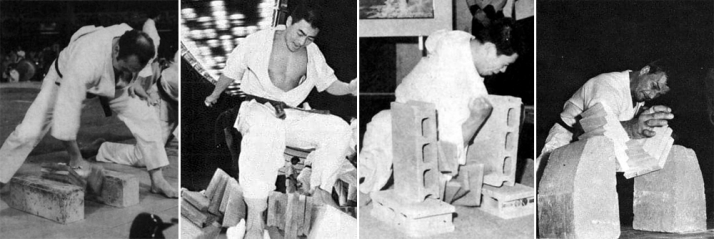
The World Open Karate Championship is held once every 4 years and gather the strongest kyokushin fighters throughout the world on the tatami. The number of participants varies from 128 to 250 (it depends on the year).
At the 1st World Open Karate Championship all competitors performed tameshiwari as it was the admission to the fights. Tameshiwari began with 1/64 (128) until 1980 (for more information see the article Evolution of sports tameshiwari in Kyokushinkai).
Since the 3rd World Open Karate Championship only those fighters were allowed to the tameshiwari who passed the final day of the competition and entered the TOP 32.
The winner of the World Open Karate Championship was twice determined by the results of tameshiwari. Such decisions were made more often at earlier rounds of the tournament.
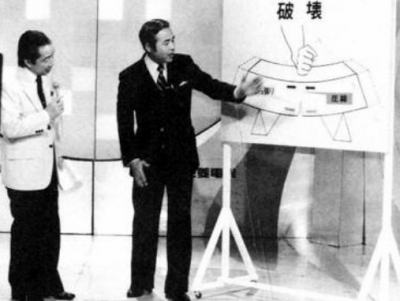 The tameshiwari results should not be underestimated. They are often connected with injuries including fractures and severe bruises, after which it is impossible to continue fighting for the highest places.
The tameshiwari results should not be underestimated. They are often connected with injuries including fractures and severe bruises, after which it is impossible to continue fighting for the highest places.Goderzi Kapanadze tameshiwari at the 10th World Open Karate Championship is one of the prime examples. Performing tameshiwari he seriously injured his right hand. Goderzi had to continue the remaining five fights with a cast. It is possible that if he had not hurt his hand, Kapanadze would have seriously changed the order of the medalists.
To be successful in tameshiwari, only practice it is not enough. To set world records it requires a fusion of spirit, technique and body.
The number of attempts and the difference in weight determined the tameshiwari winners of the three World Open Karate Championships. The equal number of broken boards was the reason.
Russian fighters are the leaders in breaking boards
Three of the five best achievements of tameshiwari at the World Open Karate Championships belong to the participants from Russia. Russians got the Best Tameshiwari Award four times.
Lechi Kurbanov is the absolute record holder.
Tameshiwari (breaking stuff) records at the
World Open Karate Championships (WC)
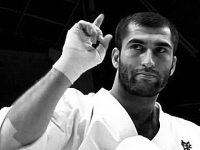 Absolute tameshiwari records at the World Open Karate Championships
Absolute tameshiwari records at the World Open Karate ChampionshipsBy the sum of four positions: Seiken (fore-fist), Sokuto (knife-foot), Enpi (elbow), Shuto (knife hand)
1st place. 31 boards — Lechi Kurbanov (Russia — 9WC)
2nd place. 29 boards — Akira Masuda (Japan — 3WC), Walter Schnaubelt (Papua New Guinea — 6WC), Sergey Plekhanov (Russia — 8WC)
3rd place. 28 boards — Ilya Karpenko (Russia — 12WC), Ewerton Texeira (Brazil 9WC), Danil Goryushkin (Russia — 12WC)
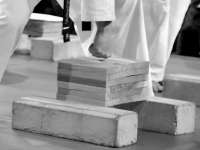 Tameshiwari records — Seiken
Tameshiwari records — Seiken(breaking boards by fore-fist)
1st place. 7 boards — Lechi Kurbanov (Russia — 8WC, 9WC)
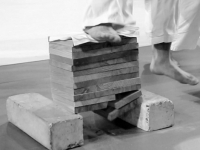 Tameshiwari records — Sokuto (Kakato)
Tameshiwari records — Sokuto (Kakato)(breaking boards by knife-foot)
1st place. 10 boards — Icaro Nascimento (Brazil — 12WC) — height 210 cm, weight 150 kg
2nd place. 9 boards — Michael Bracale (Kwazulu — 3WC), Lechi Kurbanov (Russia — 9WC), Nurmagamed Mamedov (Russia — 9 WC), David Sarhoshyan (Russia — 11 WC), Danil Goryushkin (Russia — 12 WC)
 Tameshiwari records — Enpi (Hiji)
Tameshiwari records — Enpi (Hiji)(breaking boards by elbow)
1st place. 9 boards — Lechi Kurbanov (Russia — 9 WC), Ilya Karpenko (Russia — 12 WC)
2nd place. 8 boards — Walter Schnaubelt (Papua New Guinea — 6 WC), Sergey Plekhanov (Russia — 8 WC)
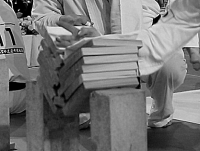 Tameshiwari records — Shuto
Tameshiwari records — Shuto(breaking boards by knife hand)
1st place. 9 boards — Walter Schnaubelt (Papua New Guinea — 6 WC)
2nd place. 8 boards — Hajime Kazumi (Japan — 6 WC), Dmitry Lunev (Russia — 9 WC)
Tameshiwari’s potential record is 35 boards (7 | 10 | 9 | 9) (combination of the best attempts at all of the World Open Karate Championships)
- Seiken (fore-fist) — 7 boards (Lechi Kurbanov)
- Sokuto (knife-foot) — 10 boards (Icaro Nascimento)
- Enpi (elbow) — 9 boards (Lechi Kurbanov, Ilya Karpenko)
- Shuto (knife hand) — 9 boards (Walter Schnaubelt)
The maximum quantity of broken boards at the tournaments (except for the 1st and 2nd World Open Karate Championships):
- Total number — 667 boards (on average ≈20,8 boards per person) / 9WC
- Seiken — 132 boards (≈4,1 boards per person) / 6WC
- Sokuto — 197 boards (≈6,1 boards per person) / 12WC
- Enpi — 181 boards (≈5,6 boards per person) / 9WC
- Shuto — 164 boards (≈5,1 boards per person) / 9WC
The minimum quantity of broken boards at the tournaments:
- Total number — 516 boards (on average ≈16,1 boards per person) / 10WC
- Seiken — 95 boards (≈2,9 boards per person) / 10WC
- Kakato — 145 boards (≈4,5 boards per person) / 4WC
- Enpi — 132 boards (≈4,1 boards per person) / 5WC
- Shuto — 117 boards (≈3,6 boards per person) / 10WC
- Personal achievement — 9 boards — Francisco Filho (3 | xx | 3 | 3) / 5WC и Amet Yunusov (xx | 3 | 3 | 3) / 10WC
- World Kumite Champions have never become the tameshiwari winners at the same time.
- Zahari Damyanov is the only one of the Kumite Champions who won tameshiwari, but it was in different years
- The best result of the world kumite champion’s tameshiwari is 28 broken boards (Ewerton Texeira)
- The worst result of the world kumite champion’s tameshiwari is 13 broken boards (Tariel Nikoleishvili)
In contrast, at the 11th World Open Karate Championship the boards broke in the best way, so only 13 failed attempts were recorded.
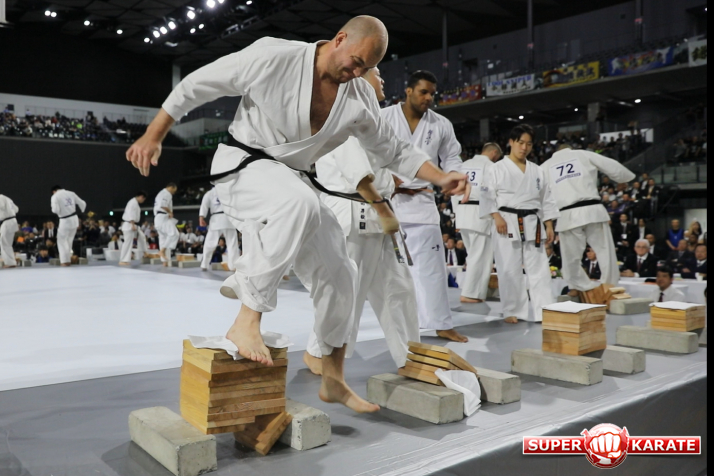
During the 12th World Open Karate Championship Aleksandr Bedoshvil (Russia) tried (unsuccessfully) to break 12 boards by exercise kakato (heel), however only two lower ones broke. That was the maximum number of boards per attempt ever recorded.
Top tameshiwari results with unsuccessful attempts
- The maximum number of broken boards with one failed attempt is 26
(Lechi Kurbanov (7 | 8 | 8 | 0/3) 8WC and Dmitry Lunev (0/3 | 7 | 8 | 8) 9WC) - The maximum number of broken boards with two failed attempts is 21
(Masato Ikeda (0/3 | 8 | 7 | 0/3) 8WC) - The maximum number of broken boards with three failed attempts is 16
(Yuuki Fukui (0/3 | 7 | 0/3 | 0/3) 8WC и Andrey Luzin (0/3 | 7 | 0/3 | 0/3) 12WC)
at the World Open Karate Championships
The 1st World Open Karate Championship - Tameshiwari (1975)
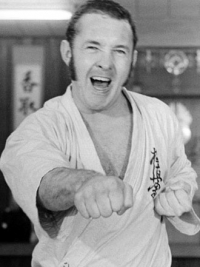 Best Tameshiwari Award: Howard Collins(UK)
Best Tameshiwari Award: Howard Collins(UK)— 19 boards (4 | 4 | 5 | 6)
Sato Toshikazu had the same result — 19 boards (4 | 6 | 4 | 0/5), but he had one unsuccessful attempt.
Tameshiwari tournament statistics
— The minimum score — 15 boards (3 | 4 | 4 | 4)
— The sum of the all participants’ best attempts — 21 boards (4 | 6 | 5 | 6)
— The total number of broken boards — 886.
- Seiken — 446 boards (all competitors had to break the boards before the first round — 1/64)
- Sokuto — 258 boards (they were broken by fighters who passed into the second round — 1/32)
- Enpi — 129 boards (1/16)
- Shuto — 53 boards (1/8)
(x — unsuccessful attempt, 4x — number of unsuccessful attempts, xx — both attempts failed)
- Seiken — (2хх)
- Sokuto — (3х)
- Enpi — (1х)
- Shuto — (4х)
The 2nd World Open Karate Championship - Tameshiwari (1979)
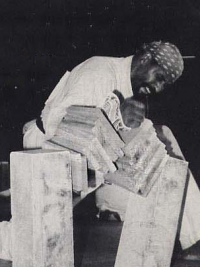 Best Tameshiwari Award: Willie Williams (USA)
Best Tameshiwari Award: Willie Williams (USA)— 26 boards (5 | 6 | 7 | 8)
Tameshiwari tournament statistics
— The minimum score — 12 boards (4 | 5 | 3 | 0) Hatsuo Royama was withdrawn from the final attempt and from the tournament by the doctor.
— The sum of the all participants’ best attempts — 28 boards (6 | 7 | 7 | 8)
— The total number of broken boards — 856
- Seiken — 367 boards (avg ≈3,2) | 1/64 — 112 athletes
- Sokuto — 280 boards (avg ≈4,3) | 1/32 — 64 athletes
- Enpi — 138 boards (avg ≈4,3) | 1/16 — 32 athletes
- Shuto — 71 boards (avg ≈4,7) | 1/8 — 15 athletes (one was withdrawn by the doctor)
- Seiken — no data
- Sokuto — no data
- Enpi — no data
- Shuto — no data
The 3rd World Open Karate Championship - Tameshiwari (1984)
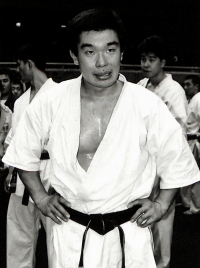 Best Tameshiwari Award: Akira Masuda (Japan)
Best Tameshiwari Award: Akira Masuda (Japan)— 29 boards (6 | 8 | 7 | 8)
Tameshiwari tournament statistics
— The minimum score — 12 boards (6 athletes)
— The sum of the all participants’ best attempts — 30 boards (6 | 9 | 7 | 8)
— The total number of broken boards — 605 (on average ≈18,9 boards per athlete)
- Seiken — 125 boards (avg ≈3,9)
- Sokuto — 178 boards (avg ≈5,5)
- Enpi — 150 boards (avg ≈4,6)
- Shuto — 152 boards (avg ≈4,7)
- Seiken — no data
- Sokuto — no data
- Enpi — no data
- Shuto — no data
The 4th World Open Karate Championship - Tameshiwari (1987)
 Best Tameshiwari Award:
Best Tameshiwari Award: — 22 boards (5 | 6 | 5 | 6)
Tameshiwari tournament statistics
— The minimum score — 12 boards (five athletes)
— The sum of the all participants’ best attempts — 25 boards (6 | 7 | 6 | 6)
— The total number of broken boards — 536 (on average ≈16,7 boards per athlete)
- Seiken — 116 boards (avg ≈3,6)
- Sokuto — 145 boards (avg ≈4,5)
- Enpi — 136 boards (avg ≈4,2)
- Shuto — 139 boards (avg ≈4,3)
- Seiken — no data
- Sokuto — no data
- Enpi — no data
- Shuto — no data
The 5th World Open Karate Championship - Tameshiwari (1991)
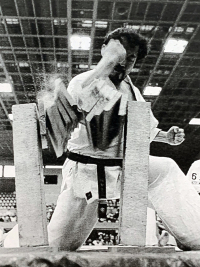 Best Tameshiwari Award: Kiyofumi Abe (Japan)
Best Tameshiwari Award: Kiyofumi Abe (Japan)— 24 boards (3 | 7 | 7 | 7)
Tameshiwari tournament statistics
— The minimum score — 9 boards (3 | 0/0 | 3 | 3) — Francisco Filho
— The sum of the all participants’ best attempts — 27 boards (5 | 8 | 7 | 7)
— The total number of broken boards — 541 (on average ≈16,9 boards per athlete)
- Seiken — 114 boards (avg ≈3,5)
- Sokuto — 153 boards (avg ≈4,7)
- Enpi — 142 boards (avg ≈4,4)
- Shuto — 132 boards (avg ≈4,1)
- Seiken — up to 18х (final data is being updated)
- Sokuto — up to 9х + 1хх (final data is being updated)
- Enpi — up to 13х (final data is being updated)
- Shuto — up to 11х (final data is being updated)
The 6th World Open Karate Championship - Tameshiwari (1995)
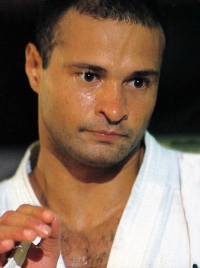 Best Tameshiwari Award: Walter Schnaubelt (Australia)
Best Tameshiwari Award: Walter Schnaubelt (Australia)— 29 boards (4 | 8 | 8 | 9)
Tameshiwari tournament statistics
— The minimum score — 13 boards (4 | 3 | 3 | 3)
— The sum of the all participants’ best attempts — 30 boards (5 | 8 | 8 | 9)
— The total number of broken — 649 (on average ≈20,2 boards per athlete)
- Seiken — 132 boards (avg ≈4,1)
- Sokuto — 188 boards (avg ≈5,8)
- Enpi — 168 boards (avg ≈5,2)
- Shuto — 161 boards (avg ≈5,0)
- Seiken — no data
- Sokuto — no data
- Enpi — no data
- Shuto — no data
The 7th World Open Karate Championship - Tameshiwari (1999)
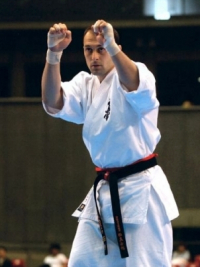 Best Tameshiwari Award: Emil Kostov (Bulgaria)
Best Tameshiwari Award: Emil Kostov (Bulgaria)— 25 boards (5 | 7 | 7 | 6)
Four more athletes showed the same result (25 boards): Nicholas Pettas, Glaube Feitosa, Zander Sasaki и Simphwe Dlulane.
Nicholas Pettas и Zander Sasaki made second attempts, Glaube Feitosa и Simphwe Dlulane were heavier than Kostov.
Tameshiwari tournament statistics
— The minimum score — 12 boards (у четверых спортсменов)
— The sum of the all participants’ best attempts — 29 boards (6 | 8 | 8 | 7)
— The total number of broken boards — 610 (on average ≈19,0 boards per athlete)
- Seiken — 123 boards (avg ≈3,8)
- Sokuto — 170 boards (avg ≈5,3)
- Enpi — 172 boards (avg ≈5,3)
- Shuto — 145 boards (avg ≈4,5)
- Seiken — 8х
- Sokuto — 8х
- Enpi — 2х
- Shuto — 7х
The 8th World Open Karate Championship - Tameshiwari (2003)
 Best Tameshiwari Award: Sergey Plekhanov (Russia)
Best Tameshiwari Award: Sergey Plekhanov (Russia)— 29 boards (6 | 8 | 8 | 7)
Tameshiwari tournament statistics
— The minimum score — 11 boards (0/0 | 4 | 4 | 3) — Alexandre Pichkounov
— The sum of the all participants’ best attempts — 32 boards (7 | 8 | 8 | 7)
— The total number of broken boards — 559 (on average ≈17,4 boards per athlete)
- Seiken — 125 boards (avg ≈3,9)
- Sokuto — 165 boards (avg ≈5,1)
- Enpi — 142 boards (avg ≈4,4)
- Shuto — 127 boards (avg ≈3,9)
- Seiken — 12х, 1хх
- Sokuto — 10х
- Enpi — 12х
- Shuto — 12х
The 9th World Open Karate Championship - Tameshiwari (2007)
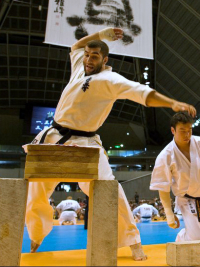 Best Tameshiwari Award: Lechi Kurbanov (Russia)
Best Tameshiwari Award: Lechi Kurbanov (Russia)— 31 boards (7 | 9 | 9 | 6)
Tameshiwari tournament statistics
— The minimum score — 12 boards (у трех человек)
— The sum of the all participants’ best attempts — 33 boards (7 | 9 | 9 | 8)
— The total number of broken boards — 667 (on average ≈20,8 boards per athlete)
- Seiken — 131 boards (avg ≈4,0)
- Sokuto — 191 boards (avg ≈5,9)
- Enpi — 181 boards (avg ≈5,6)
- Shuto — 164 boards (avg ≈5,1)
- Seiken — 10х
- Sokuto — 4х
- Enpi — 2х
- Shuto — 5х
The 10th World Open Karate Championship - Tameshiwari (2011)
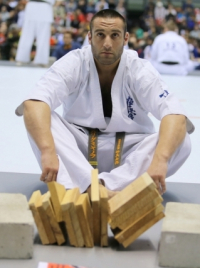 Best Tameshiwari Award: Zahari Damyanov (Bulgaria)
Best Tameshiwari Award: Zahari Damyanov (Bulgaria)— 24 boards (4 | 7 | 7 | 6)
Tameshiwari tournament statistics
— The minimum score — 9 boards (xx | 3 | 3 | 3) — Amet Iunusov (Ukraine)
— The sum of the all participants’ best attempts — 26 boards (5 | 8 | 7 | 6)
— The total number of broken boards — 516 (on average ≈16,1 boards per athlete)
- Seiken — 95 boards (avg ≈2,9)
- Sokuto — 167 boards (avg ≈5,2)
- Enpi — 137 boards (avg ≈4,2)
- Shuto — 117 boards (avg ≈3,6)
- Seiken — 19х, 5хх
- Sokuto — 6х
- Enpi — 12х
- Shuto — 10х, 1хх
The 11th World Open Karate Championship - Tameshiwari (2015)
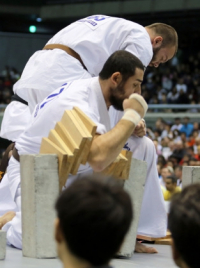 Best Tameshiwari Award: Sarkhoshyan David (Russia)
Best Tameshiwari Award: Sarkhoshyan David (Russia)— 25 boards (4 | 9 | 6 | 6)
Tameshiwari tournament statistics
— The minimum score — 12 boards (three athletes)
— The sum of the all participants’ best attempts — 27 boards (5 | 9 | 7 | 6)
— The total number of broken boards — 603 (on average ≈18,8 boards per athlete)
- Seiken — 123 boards (avg ≈3,8)
- Sokuto — 184 boards (avg ≈5,7)
- Enpi — 161 boards (avg ≈5,0)
- Shuto — 135 boards (avg ≈4,2)
- Seiken — 2х, 1хх
- Sokuto — 4х
- Enpi — 2х
- Shuto — 4x
The 12th World Open Karate Championship - Tameshiwari 2019 год
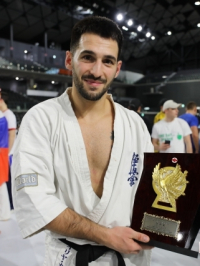 Best Tameshiwari Award: Ilya Karpenko (Russia)
Best Tameshiwari Award: Ilya Karpenko (Russia)— 28 boards (5 | 8 | 9 | 6)
Danil Goryushkin (Russia) had the same result – 28 boards (5 | 9 | 7 | 7). The tameshiwari winner was determined by the difference in weight. Ilya Karpenko (91,7kg) was lighter than Danil Goryushkin (109kg), so he won.
Tameshiwari tournament statistics
— The minimum score — 12 boards (х3 | х3 | х3 | 3)
— The sum of the all participants’ best attempts — 31 boards (5 | 10 | 9 | 7)
— The total number of broken boards — 616 (on average ≈19,2 boards per athlete)
- Seiken — 123 boards (avg ≈3,8)
- Sokuto — 197 boards (avg ≈6,1)
- Enpi — 160 boards (avg ≈5,0)
- Shuto — 136 boards (avg ≈4,2)
- Seiken — 6х
- Sokuto — 4х
- Enpi — 6х
- Shuto — 6х
SuperKarate.RU: We do not allow posting this article on third-party resources!


 SuperKarate.RU
SuperKarate.RU

